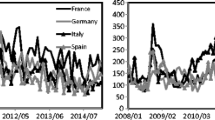Abstract
This paper explores for spillovers from monetary policy in the United States to a number of advanced countries, namely Canada, Denmark, the Eurozone, Japan, Sweden, Switzerland, and the United Kingdom. We use monthly data, from January 1997 to December 2017, and a bivariate structural GARCH-in-Mean VAR to investigate the effects of positive and negative U.S. monetary policy shocks, and also whether monetary policy uncertainty in the United States has had statistically significant spillover effects on each of the other advanced countries. Our evidence suggests that positive (negative) U.S. monetary policy shocks increase (reduce) the policy rate in each of the other countries, and that monetary policy uncertainty in the United States has a negative and statistically significant effect on the monetary policy rate of each of the other countries.









Similar content being viewed by others
References
Cúrdia V, Woodford M (2011) The central-bank balance sheet as an instrument of monetary policy. J Monet Econ 58:54–79
Dickey DA, Fuller WA (1981) Likelihood ratio tests for autoregressive time series with a unit root. Econometrica 49:1057–1072
Edwards S (2018) Finding equilibrium: on the relation between exchange rates and monetary policy. Bank for International Settlements, Working Paper No 96
Elder J, Serletis A (2010) Oil price uncertainty. Journal of Money Credit and Banking 42:1137–1159
Elliot BE, Rothenberg TJ, Stock JH (1996) Efficient tests of the unit root hypothesis. Econometrica 64:13–36
Gai P, Kapadia S (2010) Contagion in financial networks. Proc R Soc A 466:2401–2423
Hamilton JD (1994) Time series analysis. Princeton University Press, Princeton
Keister T, Martin A, McAndrews J (2008) Divorcing money from monetary policy. Federal Reserve Bank of New York Economic Policy Review 14:41–56
Kilian L, Vigfusson RJ (2011) Are the responses of the U.S. economy asymmetric in energy price increases and decreases? Quant Econ 2:419–453
Kwiatkowski D, Phillips PCB, Schmidt P, Shin Y (1992) Testing the null hypothesis of stationarity against the alternative of a unit root. J Econ 54:159–178
Nicar S (2015) International spillovers from U.S. fiscal policy shocks. Open Econ Rev 26:1081–1097
Rey H (2016) International channels of transmission of monetary policy and the Mundellian trilemma. IMF Econ Rev 64:6–35
Pagan A (1984) Econometric issues in the analysis of regressions with generated regressors. Int Econ J 25:221–247
Serletis A, Istiak K, Gogas P (2013) Interest rates, leverage, and money. Open Econ Rev 24:51–78
Stockhammar P, Österholm P (2017) The impact of U.S. uncertainty shocks on small open economies. Open Econ Rev 28:347–368
Whitesell W (2006) Interest rate corridors and reserves. J Monet Econ 53:1177–1195
Author information
Authors and Affiliations
Corresponding author
Rights and permissions
About this article
Cite this article
Nsafoah, D., Serletis, A. International Monetary Policy Spillovers. Open Econ Rev 30, 87–104 (2019). https://doi.org/10.1007/s11079-018-9505-0
Published:
Issue Date:
DOI: https://doi.org/10.1007/s11079-018-9505-0




